|
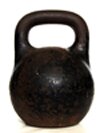 CLASSIC FITNESS SERIES CLASSIC FITNESS SERIES
What Are Kettlebells? Weight Lifting Times Ten
This is the fourth article in the series. With each installment, I'll break down a timeless classic, demonstrating how to get the most out of an old favorite. This issue looks at an unbelievably effective conditioning tool sweeping America, Kettlebells.
They've been described as Russian dumbbells, a cannon ball with a handle, and as the subtitle of this article implies, weight lifting times ten.
IN THIS ARTICLE YOU'LL LEARN
· Brief history and science behind kettlebell training
· What others have accomplished with this remarkable tool
· How one simple exercise can transform your body
With roots in eastern Europe, kettlebells have a deep international history. There's even speculation that they were used by ancient Greek athletes and gladiators thousands of years ago.
Kettlebells were also the training tool of choice for many strongmen of the early 1900's. Weight lifting pioneers Eugen Sandow and Arthur Saxon both trained with kettlebells. "Not a single sport develops our muscular strength and bodies like kettlebells," wrote Ludvig Chaplinskiy in the Russian magazine Hercules in 1913.
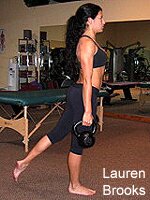 According to Lauren Brooks (Southern California fitness expert and fellow kettlebell trainer),"The best way to get a lean, sexy, well-defined physique is with heavy weights and low reps." Lauren goes on to say, "So what is the best way to develop real strength? I am firmly convinced it is kettlebell training. When I discovered kettlebells, I was hooked immediately. I stopped training with dumbbells and machines. Working with only kettlebells 2-3 times a week for 10 weeks, I lost about 4-5 percent of my body fat. I look better now than I did in college. I was amazed and so were my clients and other trainers. They begged me to teach them what I was doing." According to Lauren Brooks (Southern California fitness expert and fellow kettlebell trainer),"The best way to get a lean, sexy, well-defined physique is with heavy weights and low reps." Lauren goes on to say, "So what is the best way to develop real strength? I am firmly convinced it is kettlebell training. When I discovered kettlebells, I was hooked immediately. I stopped training with dumbbells and machines. Working with only kettlebells 2-3 times a week for 10 weeks, I lost about 4-5 percent of my body fat. I look better now than I did in college. I was amazed and so were my clients and other trainers. They begged me to teach them what I was doing."
While kettlebells all but disappeared in the west, they flourished in the former Soviet Union. In Russia, everyone from common people, to the military, to Olympic athletes trained with kettlebells. In 1948 the first official competition took place, and later it became Russia's National sport.
Russian Special Forces personnel owe much of their legendary strength, cat-like agility, and endless stamina to kettlebell training. The official armed forces strength training manual pronounced kettlebell drills to be "one of the most effective means of strength development" representing "a new era in the development of human strength-potential."
Today, there's been a rediscovery of kettlebells in the United States. Top athletes, police departments, the military and martial artist are training with KB's to stay on top of their game.
DragonDoor.com writes "K-bells forge doers physiques, along the lines of antique statues -- broad shoulders with just a hint of pecs, back muscles standing out in bold relief, wiry arms, rugged forearms, a cut midsection, and strong legs without a hint of squat-induced chafing."
My personal introduction to the glory of kettlebells came from a female client named Melissa. An accomplished runner and endurance athlete, Melissa was also a professional firefighter and fire instructor. She had some experience with kettlebell training and got me hooked. It was a match made in heaven.
I discovered a tool that could easily be adapted to just about any firefighting or sport-specific task. Pure strength, explosive power, extreme endurance, advanced flexibility, coordination, balance, and task-specific skill can all be vastly improved with this simple looking, yet incredibly challenging, ball of cast iron. From my years of first hand experience, I can tell you with authority, these are qualities that are a vital for a working firefighter, and sought after throughout all athletics.
There is no better way to simultaneously build strength and endurance, while you burn fat, than with a few high-rep sets of kettlebell swings (a common entry level KB exercise). This is a dynamic movement that works your body as one unit and requires a great deal of physical effort. The harder you work the more strength / endurance you build and calories you burn.
If you could site one drawback with kettlebell training, it would be the learning curve that's not usually associated with a simple fitness program, as kettlebells have been coined "the martial art of strength training". But luckily for the average novice, your body will begin to adapt during this initial learning process, and you'll see changes in how you look and feel almost immediately.
Below are the instructions and illustrations for the Swing, a kettlebell classic. Realizing that most people don't have a kettlebell parked out in their garage, I've included the alterative method of swinging with a dumbbell. Though not nearly as challenging, it will allow you to get the sensation and associated physiological adaptations of actual kettlebell training. Please realize that the swing is an advanced exercise, and should only be undertaken if you feel confident lifting weights. Proceed at your own risk and always get your physician's approval.
THE SWING 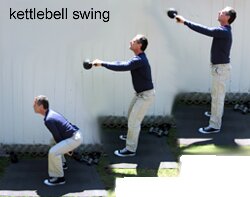
Before beginning...
Apply Tension to Abdominals
Don't confuse with this sucking in your gut. Quite the contrary, flexing your core is more like bracing for a punch. Sniff in some air, bear down and squeeze your abs, creating core/spinal stability.
Flex Glutes and Pelvic Floor
Before you move an inch, squeeze your butt cheeks together (as if to pinch a coin between your glutes), and create an anal lock (squeeze muscles that prevent a bowel movement). This protects you from many nasty conditions (such as hemorrhoids) that afflict many weight lifters who ignore this simple step.
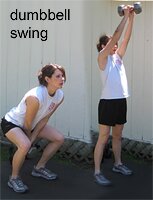 Getting Started Getting Started
Select a kettlebell or dumbbell you can safely handle for at least 10 reps. Stand with feet at hip width or wider. Toes are straight or point slightly out. With abs tight, hinge at the hips to pick you the dumbbell with two hands. Both versions of this exercise can also be done with one arm, as you may find the one-arm version more compatible when using a dumbbell (the free arm is held out for balance).
Keep your back straight (never rounded) and stick your butt back. Shins remain as vertical as possible with your body weight on your heels at the start of the lift. First swing the bell down and back between your legs for a few inches (hike a football), immediately allow (don't force) the weight to reverse direction and arms to swing forward. Arms remain straight (elbows locked) and back remains straight or slightly arched, not rounded.
With synchronized hip and upper body motion, (body weight is on your heels as much as possible) thrust your hips forward and swing (full arc, arms straight) the bell to chest height in one motion. Be sure back stays straight and never rounds. Lock out hips (clench glutes hard, keep abs and quads tight) at the top of the motion. This should be fairly easy unless you attempt too heavy a weight. Work on timing the hip thrust with arm swing. If you don't use any upper body muscular effort this will come naturally.
Points to Remember
Back stays arched, shoulders back, shins vertical, glutes and abs tight as you swing the weight anywhere from waist height (beginners) to chest height, or higher. As shown in the photo, the models are perfectly straight (not leaning backward) at the top of the swing. Never lean or scoop under the weight. Allow the weight to swing back down in the same arc, bend at the hips and catch the weight your hips, glutes and hamstrings (absorbing momentum). Like a sling-shot, immediately reverse direction of the bell and again thrust forward for another rep. Imagine sitting on a hot stove.
Do not try and control the downswing with muscular effort. The arms should feel like ropes and the hands like hooks. Gently guide the bell instead of trying to alter its path with your arms. Remember to use the momentum from the downswing, reverse the direction and snap your hips once again. Coordinate your breathing with your movements (exhale up, inhale down works for most people).
Rep potential is unlimited, from 10 to 30 or more. When form fades, end the set. Rest as long as necessary between sets. This move builds super endurance as well as explosive power. Most men should start with a 20 to 35 pound bell, while women should start with a 10 or 15 pounder.
For more classic exercises, customized to your exact needs: click here
RECENT STUDIES
1983: Voropayev observed two groups of subjects over a period of a few years and tested them with a standard battery of armed forces PT tests: pullups, a standing broad jump, a 100m sprint, and a 1k run. The control group followed a typical university physical education program that emphasized the above. The experimental group just lifted kettlebells. In spite of the lack of practice on the tested exercises, the kettlebell group showed better scores in every one.
1986: Researchers at the Lesgaft Physical Culture Institute in Leningrad (Vinogradov & Lukyanov) found a very high correlation between the results posted in a kettlebell lifting competition and a great range of dissimilar tests; strength, measured with the three powerlifts and grip strength; strength endurance, measured with pullups and parallel bar dips; general endurance, determined by a 1000 meter run; and work capacity and balance, measured with special tests.
1993: Shevtsova discovered that kettlebell training can have a dramatic positive impact on the user's heart rate and the blood pressure.
1997: Kettlebells melt fat without extreme dieting or aerobics, and losing one percent of bodyfat a week for weeks is not uncommon. At the same time, if you're too thin, you'll pack on muscle. According to Voropayev who studied top Russian KB lifters, 21.2 percent increased their bodyweight since taking up kettlebelling and 21.2 percent (the exact same percentage, not a typo), mostly heavyweights, decreased it.
1997: Kettlebell training, when compared to other forms of strength training is beyond safe. Less than nine percent of top Russian KB'ers reported injuries in training or competition (Voropayev), a remarkably low number when considering the level of training, as these were elite athletes who repeatedly push their bodies to the limit.
1998: Gomonov concluded that "Exercises with kettlebells enable one to quickly build strength, endurance, achieve a balanced development of all muscle groups, fix particular deficiencies of build, and promote health."
ARTICLE RESOURCE:
Lauren Brooks
OnTheEdgeFitness.Com
Lauren is a personal trainer and kettlebell expert in the Southern California area.
DragonDoor.com
The website for extreme fitness and well-being
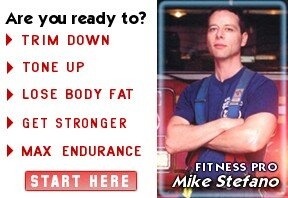 MICHAEL STEFANO is the creator and author of the Firefighter's Workout (Harper Collins 2000). Mr. Stefano is a health and fitness writer, contributor to eDiets, eFitness, and Firehouse.Com. Michael's articles have appeared on AOL, MSN, and Yahoo! His workouts have been featured in magazine and newspapers from around the country, as well as in numerous network and cable TV segments. He also offers an online version of his FitFlash custom program, via a comprehensive 22-point fitness profile form. MICHAEL STEFANO is the creator and author of the Firefighter's Workout (Harper Collins 2000). Mr. Stefano is a health and fitness writer, contributor to eDiets, eFitness, and Firehouse.Com. Michael's articles have appeared on AOL, MSN, and Yahoo! His workouts have been featured in magazine and newspapers from around the country, as well as in numerous network and cable TV segments. He also offers an online version of his FitFlash custom program, via a comprehensive 22-point fitness profile form.
Mike offers online personalized workouts for firefighters, candidates, and civilians.
BACK TO TOP OF PAGE
ALL MAJOR CREDIT CARDS ACCEPTED

BUY NOW
|